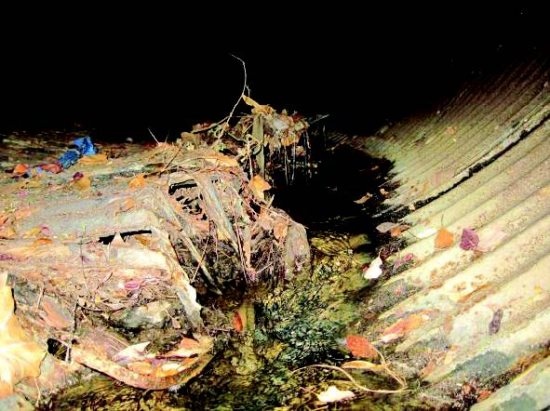
| ||||||
At the first two community meetings on Feb. 12, between 12 and 25 residents came to the council chambers to ask questions of town officials, staff and consultants, who are preparing for the March 14 public hearing. Edric Kwan, the public works director, was there to defend a mechanism that will give him the resources to implement the storm drain master plan he developed in 2015. It took the sinkhole on Rheem Boulevard and the scare of having funding withheld by the Federal Emergency Management Agency because of Moraga's lack of maintenance, for the council to make the political decision to finally address the issue.
Some residents who attended the community meetings asked staff and the elected officials present, such as Mayor Dave Trotter, why the issue had not been addressed any sooner. Jim Holgersson, interim town manager who has managed nine cities in five different states, said that Moraga faces the issue of lack of infrastructure maintenance as many other jurisdictions do and is willing to address it as best it can. He confirmed that Moraga is indeed very thriftily managed and has been for years, with the lowest per capita expense in the region.
The statement did not stop resident Seth Freeman from noting that the money that the new fee will generate corresponds to about 10 percent of the town's total payroll. He also criticized the fact that councils over the last 12 years never saved money for infrastructure maintenance and capital replacement.
Freeman and other residents asked to see a detailed expenditure plan with what public works would do with the fee if it passes.
Kwan explained that the money will be used for three categories of expenses: a first and biggest portion of the revenue will be used to service the debt of a loan the town will contract to address the high-priority storm drain areas that were identified three years ago with televised exploration and ground inspection - the director noted that the Rheem sinkhole was on that list of high-priority areas - a second portion will be used to maintain the rest of the network; the third will allow the town to meet its state unfunded mandate to eliminate all pollution in the storm drain system.
Kwan presented the maintenance as very critical to the plan. Besides the $9 million of capital improvement work needed to tackle the high-priority risk areas, the town has identified over $20 million of medium- and low-priority issues that will also need to be addressed. Kwan said that having a maintenance budget of about $250,000 a year will enable his team to conduct inspections, remove sediments and debris, and make spot repairs that he believes will significantly increase the life of the system. Some residents were not completely convinced by the director's explanations and asked why the town was not asking for more money in order to deal with the totality of the issue.
The long-term need to maintain the system, to comply with state clean water requirements, and later on, to focus on medium-priority areas explain why there is no sunset to the storm drain fee. Trotter compared the new fee to the light assessment district that has been in place in Moraga for over 40 years. Every year an engineering report is presented and the fee is adjusted to cover the needs. The mayor believes that the same process will be applied to the storm drain fee and that if, in the future, needs decrease, so would the fee. The increase is capped at 3 percent by law.
Schools, churches, and commercial areas do not pay a fee per parcel, like the vast majority of the property owners in Moraga. The fee is a per acre amount, more for commercial properties than for schools, depending on the quantity of impermeable surfaces each contain. A resident asked how much the Moraga School District would pay and the mayor indicated an amount in the area of $21,000 a year. That resident noted that this amount should be added to what residents will have to pay, since the school district is funded by them.
Saint Mary's College, which is exempt of property tax payments, will pay the storm drain fee if passed, and so will homes located in open space areas. The highest rate will affect commercial properties since they are mostly covered with structures and parking lots, all impervious surfaces that do not absorb any rain.
For the measure not to go to the ballot, a majority of the residents would need to protest the fee by sending a letter to the town clerk identifying their property before the March 14 meeting. Otherwise, residents will receive one ballot per property at the end of March and will have until May 15 to return it to the town clerk. Town Clerk Marty McInturf will count the ballots during a public session. Fifty percent plus one supporting ballots have to be received in order for the new fee to be applied. At the time this article went to press, approximately 50 letters of protest had been received by the town.
Reach the reporter at:
